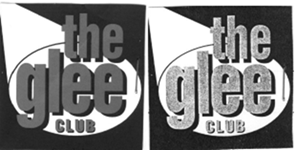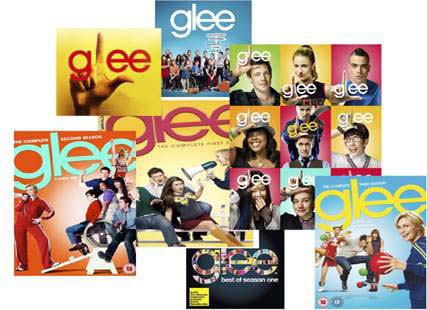Article
Glee for Comic Enterprises as Court of Appeal confirms The Glee Club's trade mark infringed by Foxs glee TV show
10
Acting for Comic Enterprises (owners of The Glee Club comedy and music chain) ('Comic'), Wragge Lawrence Graham & Co has succeeded before the Court of Appeal, confirming a finding of trade mark infringement in favour of Comic.
The Court of Appeal confirmed that Comic's trade mark, the series of two device marks depicted below, was infringed by 20th Century Fox's ('Fox's') hit TV show 'glee', but that Fox's activities did not amount to passing off. The validity of Comic's trade mark remains to be determined, following Fox's challenge to the validity of all series marks.
Central to the case was the relevance of evidence of so-called 'wrong way round confusion' (i.e. where members of the public who were aware of the alleged infringing sign came across the trade mark for the first time and were confused into believing that the two were connected). Such evidence was in issue both in the context of the tests for infringement under sections 10(2) and 10(3) of the Trade Marks Act (TMA), and in the context of the law of passing off.
Partner and Brands specialist Cerryg Jones led the case for Comic, with senior associate Nick Smee acting as the lead associate. Douglas Campbell, who has since been elevated to QC, acted as counsel for Comic.
Background
Comic operates entertainment venues in Birmingham, Cardiff, Oxford and Nottingham. These venues are primarily used for stand-up comedy but also offer live music, nightclub and cabaret entertainment.
In 1999, Comic registered UK trade mark 2200698 (the 'Mark') in relation to a number of services, including entertainment services, comedy services, the provision of live and recorded music and the production and presentation of live shows. The Mark consists of a series of two marks, as shown below:

Fox's television series 'glee' follows an American high school singing club at the fictional William McKinley High School in the town of Lima, Ohio. Examples of its use of the sign "glee" are as follows:

Comic found that potential customers were assuming that its business was connected to the TV series. It brought a claim for trade mark infringement under sections 10(2) and (3) TMA and a claim for passing off. Fox counterclaimed that the Mark was invalid and that the specification was too broad.
In February 2014, the High Court of England and Wales handed down its judgment, partially revoking the Mark for non-use. However, the Mark remained validly registered in respect of services including 'live comedy services' and 'provision of live and recorded music', and was infringed by Fox's use of 'glee' pursuant to sections 10(2) and 10(3) TMA. Comic's passing off claim was unsuccessful. For a summary of the High Court's judgment please see our earlier commentary here.
Fox appealed the finding of trade mark infringement; Comic appealed on passing off.
The Court of Appeal concluded that the first instance judge had fallen into error, and consequently reconsidered much of the evidence; nevertheless the High Court's findings in respect of both trade mark infringement and passing off were confirmed.
Can confusion be the "wrong way round"?
Under section 10(2) TMA a registered trade mark is infringed by a sign where, because the sign is similar to the registered mark and used for identical or similar services, there exists a likelihood of confusion on the part of the public. In the usual scenario, members of the public who are already aware of the mark come across the infringing sign and are confused into believing it came from the same or a connected undertaking.
However, in the Glee case, most of the evidence of confusion was the other way around, i.e. members of the public who were aware of the 'glee' TV show came across the trade mark for the first time and were confused into believing that the two were connected. It fell to be determined whether such "wrong way round confusion" was relevant to the assessment of infringement.
Fox contended (among other arguments) that "wrong way round confusion" is irrelevant as a matter of law, given that such confusion can only arise after the relevant date of assessment (being the date on which the sign first started to be used).
The Court of Appeal disagreed. Lord Justice Kitchin, who gave the leading judgment, ruled that in every case the test for infringement remains the same: the question is whether, having regard to a notional and fair use of the mark in relation to all of the goods or services for which it is registered, and having regard to the use of the sign, there is a risk that the average consumer might think the goods or services come from the same or linked undertakings.
Kitchin LJ explained that, although the relevant date for assessment remains the date on which the use of the sign alleged to infringe first began, the infringement analysis involves an element of looking forward. The question is whether there is a likelihood of confusion in light of the defendant's actual and threatened activities. Evidence that comes to light at a later date may assist the court in answering that question. For both 'right' and 'wrong' way round confusion, the consumer thinks that the goods and services come from the same or linked undertakings. Both types of confusion may be equally damaging to the distinctiveness and functions of the trade mark.
Kitchin LJ therefore rejected Fox's submission that "wrong way round confusion" is inadmissible. However, he warned that evidence of "wrong way round confusion" must be assessed with care along with all the other evidence that may assist in answering the statutory question in the context of any particular case.
Upon re-evaluating the evidence, the Court of Appeal found that there was a reasonable degree of similarity between both the Mark and Fox's sign and the respective services, and that, considering other factors, including the context of Fox's use of the sign, there was a likelihood of confusion.
Is wrong way round confusion relevant under section 10(3) TMA?
Section10(3) TMA provides that a registered mark with a reputation in the UK will be infringed where the use of a sign, being without due cause, takes unfair advantage of, or is detrimental to, the distinctive character or repute of the mark. To infringe, the average consumer must establish a 'link' between the mark and sign.
Fox contended that, since section 10(3) is founded upon the reputation of the registered trade mark relied upon, the requisite 'link' must be made by average consumers who are already familiar with the mark.
However, applying Intel, the Court of Appeal held that a global assessment of all relevant factors was required. Such factors included the similarity between the registered mark and the sign and the similarity between the related services, the mark's distinctive character and the strength of its reputation, and also the existence of a likelihood of confusion.
After assessing such factors, the Court of Appeal concluded that Fox's use of the sign would bring Comic's Mark to mind. The evidence of 'wrong way round' confusion helped to demonstrate that Fox's use of 'glee' would cause average consumers to make the requisite connection.
The Court of Appeal also found that the scale of Fox's use of 'glee' was having a serious impact upon Comic's business and its ability to use its mark for the purpose of identifying and promoting its venues. Its power to attract customers had been seriously impaired.
Passing off
As regards Comic's claim for passing off, the Court of Appeal found that Comic had established goodwill in and under the Mark as well as in the word 'glee' by late 2009.
However, Kitchin LJ was not persuaded that the launch of the 'glee' TV series amounted to a misrepresentation such as to cause a significant number of consumers to believe that the business behind the Birmingham and Cardiff venues (which predated the TV show) was the same as, or connected to, the business behind the show. The goodwill associated with the Birmingham or Cardiff venues had not been materially affected by the launch of the series. The real problems came to light when Comic opened its Nottingham and Oxford venues in 2010.
Accordingly, the Court of Appeal confirmed the High Court's finding that Comic's claim for passing off did not succeed.
Rationalising the contrasting conclusions on trade mark infringement and passing off, Kitchin LJ explained that when assessing a trade mark, the court need not restrict its consideration to the particular way the mark has actually been used and the goodwill that has been generated; rather it may take into account a notional fair use of the mark in relation to all of the goods and services for which it is registered.
Are series marks valid?
One further issue still remains to be determined by the Court of Appeal; namely whether the Mark, being a series mark, is invalid because section 41 TMA, which allows series marks to be registered, is not compatible with the requirement in EU law that a trade mark must be 'a sign' in the sense of being a single sign capable of being graphically represented. Clearly this could have far reaching implications, not only for Comic's Mark, but for all UK series marks.
Concluding remarks
The Court of Appeal's 8 February 2016 judgment in Comic v Fox provides important guidance on the relevance of 'wrong way round confusion' in the assessment of trade mark infringement and of the complementary but distinct nature of trade mark law and the English law of passing off. Look out for a further update on the case soon, once the important issue regarding the validity of series marks has been determined.
NOT LEGAL ADVICE. Information made available on this website in any form is for information purposes only. It is not, and should not be taken as, legal advice. You should not rely on, or take or fail to take any action based upon this information. Never disregard professional legal advice or delay in seeking legal advice because of something you have read on this website. Gowling WLG professionals will be pleased to discuss resolutions to specific legal concerns you may have.

